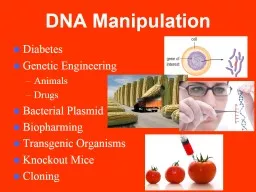

DNA Manipulation Diabetes Genetic Engineering Animals Drugs Bacterial Plasmid Biopharming Transgenic Organisms Knockout Mice Cloning DNA Manipulation What is genetic engineering What are genetically engineered foods ID: 765527
Download Presentation The PPT/PDF document "DNA Manipulation Diabetes" is the property of its rightful owner. Permission is granted to download and print the materials on this web site for personal, non-commercial use only, and to display it on your personal computer provided you do not modify the materials and that you retain all copyright notices contained in the materials. By downloading content from our website, you accept the terms of this agreement.
DNA Manipulation DiabetesGenetic EngineeringAnimalsDrugsBacterial PlasmidBiopharmingTransgenic OrganismsKnockout MiceCloning
DNA Manipulation What is genetic engineering?What are genetically engineered foods?What is Cloning?
Diabetes Diabetes mellitus is a disease caused by the inability to properly use insulin, resulting in elevated blood glucose levelsMany people require insulin injections to surviveInsulin allows glucose to be transferred from the blood into cells Approximately 5% of all deaths are caused by diabetes.
Diabetes and Biotechnology? How insulin is made?
Due to the need, actual human insulin is now mass-producedScientists insert the human insulin gene into bacteria, and the bacteria makes human insulin.This is genetic engineering, the intentional alteration of a genome by substituting or introducing new genetic material
The human gene that codes for insulin is inserted into an E. coli plasmid (small circular pieces of DNA). The E. coli (bacteria) transcribes and translates the piece of human DNA to make the human protein insulin, which is then harvested from the bacteria and put into a container to be used. Safflowers are also used to produce human insulin.
The first step in genetic recombination is to isolate, or cut out, a DNA fragment that contains the desired gene. You must also cut the circular plasmid (from the bacteria) to make it linearScientists use restriction enzymes, which act like molecular scissors, cutting a DNA molecule at specific locations.
You then insert your DNA segment into a bacterial plasmid using DNA ligaseLet the bacterial plasmid replicate and mass produce your proteinThese plasmids used for transferring foreign genetic material into a cell are called vectors
The successful introduction of DNA from another source is called transformation.The cell that has received the DNA is said to be transformed. The bacteria is said to contain recombinant DNA, which is a DNA strand that is created using pieces of DNA from two or more sources
Biopharming Genetic engineering uses DNA technology to modify the genes of a cell or an organism.Molecular biologists can introduce new functions into an organism. Today, scientists use genetic engineering to find cures for various diseases that affect animals and plants.
Perhaps most useful is the introduction of one or more genes from one organism into another. This could cause the host organism to produce a certain protein, such as insulin or clotting factors, that is useful to us. E.g. Allow us to become resistant to certain diseases, grow human organs, grow faster, etc. When such pharmaceutical products are produced on a large scale, the process is called biopharming.
Genetically Engineered Animals Industry and Medical uses from genetic engineering.
Transgenic Organisms: Altered DNA An organism that has been changed by scientists to contain one or more genes from another organism is known as a transgenic organism or a genetically modified organism (GMO).What is a GMO?
Why Use Transgenic Plants and Animals?Cost - animal and plant based methods are usually more economical (cheaper) than operating a laboratory with controlled bacterial populations. Size - larger organisms can produce more stuff
Transgenic Plants Genetically modified (GM) canola and other field crops have been engineered to be resistant to specific herbicides. This technology means that herbicides can be sprayed to kill weeds but the crop plant remains healthy. Farmers spend about 40% less on herbicides for GM canola crops versus conventional canola crops, and they report up to a 10% increase in yield.
How are GMOs created? 5 Myths about GMOs
Knockout Mice Knockout mice are produced by genetic engineering to have at least one gene completely turned off by a mutation. They are used to study the purpose of each gene.If a gene is turned off, you can more easily see what it does.
Cloning Cloning is the process of making a genetically identical organism.It has been used for many years to produce plants (even growing a plant from a cutting is a type of cloning).The first cloned mammal (Dolly) was born in 1997Since Dolly, several scientists have cloned other animals, including cows and mice.
Cloning Animals
Why Clone?The main reason to clone plants or animals is to mass produce organisms with desired qualities, such as prize-winning apples or a genetically engineered animal that produces more milk, beef, etc. Other reasons for cloning might include replacing human organs (no rejection or need of another person because they are yours) repopulating endangered or extinct species and building a clone army.
IssuesDeciding exactly where to draw the line on transgenic organisms and cloning is difficult. What is acceptable and what isn’t?Do the ends justify the means?Careers in Genetic Engineering